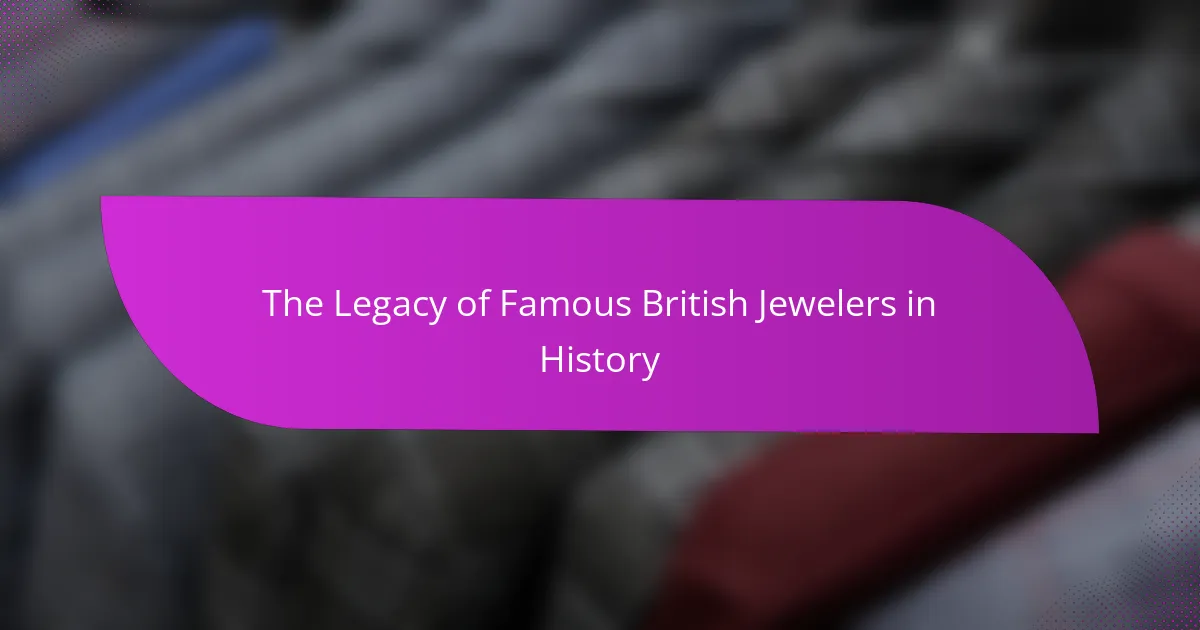The article explores the legacy of famous British jewelers, highlighting their significant contributions to jewelry design and craftsmanship throughout history. Key entities include Garrard, established in 1735, known for royal commissions and iconic pieces like the Imperial State Crown, and Asprey, founded in 1781, recognized for luxury craftsmanship and bespoke services. The article also discusses the impact of British jewelers on the Art Deco movement and their reflection of cultural shifts and societal values. Overall, it emphasizes how the standards set by these jewelers continue to influence contemporary jewelry design and inspire future artisans and designers.

What is the Legacy of Famous British Jewelers in History?
The legacy of famous British jewelers in history is characterized by innovation, craftsmanship, and influence on global jewelry design. Renowned jewelers like Garrard, founded in 1735, played a significant role in royal commissions. They created iconic pieces, such as the Imperial State Crown. Another notable name, Asprey, established in 1781, is known for luxury craftsmanship and bespoke services. British jewelers have also contributed to the Art Deco movement, showcasing unique styles and techniques. Their work often reflects cultural shifts and societal values throughout history. The craftsmanship of British jewelers has set standards that influence contemporary jewelry design worldwide. Their legacy continues to inspire new generations of artisans and designers.
How has the history of British jewelers shaped the jewelry industry?
The history of British jewelers has significantly shaped the jewelry industry through innovation and craftsmanship. British jewelers have been influential since the 16th century, introducing unique styles and techniques. The establishment of hallmarking in the 1300s ensured quality and authenticity in jewelry, setting a standard that is still respected today. Prominent figures like Garrard and Asprey have contributed to royal commissions, elevating the prestige of British jewelry. The Victorian era saw the rise of sentimental jewelry, which influenced design trends worldwide. British jewelers have also embraced modern materials and techniques, pushing the boundaries of traditional craftsmanship. This blend of heritage and innovation has made British jewelry highly sought after globally. The impact of British jewelers is evident in contemporary design, where historical influences remain prominent.
What are the key milestones in the history of British jewelry?
The key milestones in the history of British jewelry include the Roman invasion of Britain in 43 AD, introducing metalworking techniques. During the Anglo-Saxon period, intricate gold and silver jewelry became prominent, often featuring gemstones. The medieval era saw the rise of religious jewelry, including crosses and reliquaries. The Tudor period marked a significant shift with the introduction of elaborate designs and the use of enamel. The 18th century brought about the Georgian style, characterized by ornate and romantic designs. The Victorian era popularized sentimental jewelry, often featuring lockets and cameos. The Arts and Crafts movement in the late 19th century emphasized handcrafted pieces with natural motifs. The 20th century introduced modernist designs, reflecting contemporary art movements. Each milestone reflects evolving tastes and techniques in British jewelry history.
How did famous British jewelers influence design trends?
Famous British jewelers significantly influenced design trends through innovative techniques and unique aesthetics. For instance, the works of Garrard, the Crown Jeweller, set standards for royal and ceremonial jewelry. Their intricate craftsmanship and use of rare gemstones inspired luxury designs across Europe. Similarly, the Art Deco movement was shaped by jewelers like Cartier and Fabergé, who introduced geometric patterns and bold colors. This influence led to a shift in consumer preferences towards modern and stylish pieces. Additionally, the revival of traditional techniques by jewelers such as David Morris has redefined contemporary luxury. Their emphasis on bespoke designs has encouraged a trend towards personalization in jewelry. Overall, British jewelers have played a pivotal role in shaping both historical and modern design trends in the jewelry industry.
What are the most notable British jewelers and their contributions?
Notable British jewelers include Garrard, Asprey, and Boucheron. Garrard, established in 1735, is known for creating the Imperial State Crown. Asprey has a reputation for luxury goods and bespoke jewelry. Boucheron, founded in 1858, is recognized for its innovative designs and craftsmanship. Each of these jewelers has significantly influenced British jewelry design and luxury standards. Their contributions are marked by iconic pieces and a commitment to quality.
Who are the pioneering figures in British jewelry making?
Pioneering figures in British jewelry making include Thomas B. Johnson, Charles Robert Ashbee, and Georg Jensen. Thomas B. Johnson was known for his innovative designs in the late 19th century. Charles Robert Ashbee founded the Guild of Handicraft, promoting the Arts and Crafts movement. Georg Jensen, originally from Denmark, became influential in British jewelry through his elegant silver designs. Each of these figures contributed significantly to the evolution of British jewelry, shaping its aesthetic and craftsmanship. Their work is celebrated for its artistry and historical importance in the jewelry industry.
What unique techniques did these jewelers introduce?
Famous British jewelers introduced unique techniques such as the use of enameling and intricate metalwork. Enameling allowed for vibrant colors and detailed designs on jewelry pieces. This technique was perfected by jewelers like Fabergé, who utilized it to create intricate patterns. Intricate metalwork involved techniques like filigree and granulation, enhancing the overall aesthetic of jewelry. Filigree involves twisting fine metal wires into delicate designs. Granulation consists of applying tiny metal granules to create texture. These methods contributed to the distinctiveness of British jewelry during their time. The combination of these techniques set British jewelers apart in the global market.
Why is the legacy of British jewelers significant today?
The legacy of British jewelers is significant today due to their historical influence on jewelry design and craftsmanship. British jewelers have set trends that continue to inspire modern designs. Iconic pieces from the Victorian and Edwardian eras showcase intricate craftsmanship and attention to detail. Renowned jewelers such as Garrard and Asprey have established a reputation for luxury and quality. The craftsmanship standards set by these jewelers are still upheld in contemporary practices. Additionally, British jewelers have contributed to the evolution of gemstone settings and metalworking techniques. Their influence extends to global markets, where British design aesthetics remain highly sought after. This enduring legacy shapes the identity of fine jewelry today.
How does the craftsmanship of British jewelers compare to global standards?
British jewelers are known for their exceptional craftsmanship, often regarded as among the best in the world. Their techniques include intricate handwork and attention to detail. British jewelers frequently utilize high-quality materials, ensuring longevity and aesthetic appeal. The UK’s strict regulations on hallmarking guarantee authenticity and quality. In comparison, many global standards vary, with some regions emphasizing mass production over craftsmanship. Historical figures like Garrard and Asprey set benchmarks for quality in jewelry making. Their legacy continues to influence modern practices globally. Overall, British craftsmanship is distinguished by its blend of tradition and innovation, placing it at a high standard internationally.
What impact did these jewelers have on modern jewelry design?
These jewelers significantly influenced modern jewelry design through innovative techniques and unique aesthetics. Their use of color and materials transformed traditional jewelry-making practices. They introduced new forms and styles that emphasized craftsmanship and individuality. Iconic pieces from these jewelers set trends that continue to inspire contemporary designers. Their emphasis on storytelling within jewelry pieces added emotional depth to modern designs. Additionally, they championed the use of sustainable materials, paving the way for ethical practices in the industry. The legacy of their work is evident in the ongoing appreciation for artisanal and bespoke jewelry today.
How can we appreciate the craftsmanship of British jewelers?
We can appreciate the craftsmanship of British jewelers by examining their intricate designs and techniques. British jewelers often use traditional methods passed down through generations. Their work showcases a blend of artistry and precision. Notable examples include the use of hand engraving and stone setting. Many British jewelers also source high-quality materials, enhancing the value of their pieces. Historical significance adds to their craftsmanship, as many jewelers have created iconic pieces for royalty and celebrities. The craftsmanship is also reflected in awards and recognitions received by these artisans. Overall, exploring the history and techniques reveals the depth of British jewelry craftsmanship.
What are the best practices for caring for British jewelry pieces?
To care for British jewelry pieces, regularly clean them with a soft, lint-free cloth. This prevents tarnishing and maintains shine. Store jewelry in a cool, dry place. Use a jewelry box with individual compartments to avoid scratches. Avoid exposure to harsh chemicals, including perfumes and cleaning products. Remove jewelry before swimming or exercising to prevent damage. For intricate pieces, seek professional cleaning annually. British jewelry often features delicate craftsmanship, making careful handling essential. Following these practices preserves both the aesthetic and value of British jewelry.
How can one identify authentic pieces from famous British jewelers?
To identify authentic pieces from famous British jewelers, examine hallmark stamps. Hallmarks are official marks stamped on precious metals. They indicate the metal’s purity and the jeweler’s identity. Look for the Assay Office mark, which confirms the piece’s authenticity. Research the specific marks used by renowned British jewelers. Familiarize yourself with the historical context of these marks. Authentic pieces often come with provenance documentation. This documentation traces the piece’s ownership history. Reputable dealers provide certificates of authenticity for high-value items.
What resources are available for learning more about British jewelers?
Books on British jewelry history are excellent resources. Titles like “British Jewelry: 1840-1940” by Charlotte Gere provide insights into design and craftsmanship. Online platforms such as the Victoria and Albert Museum’s website offer extensive collections and articles on British jewelers. Documentaries about jewelry design, available on streaming services, explore the lives of famous jewelers. Additionally, academic journals like “The Journal of the Society of Jewelry Historians” publish research on the subject. Visiting exhibitions at museums dedicated to decorative arts can also enhance understanding. These resources collectively offer a comprehensive view of British jewelers and their legacy.
The main entity of this article is the legacy of famous British jewelers throughout history. The article examines the significant contributions of renowned jewelers such as Garrard and Asprey, highlighting their impact on craftsmanship, design trends, and the evolution of the jewelry industry. It discusses key historical milestones, unique techniques introduced by these jewelers, and their lasting influence on contemporary jewelry design. Additionally, the article covers best practices for caring for British jewelry and resources available for further learning about this rich heritage.
